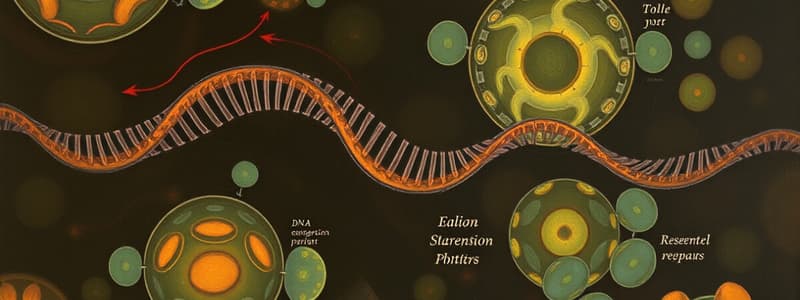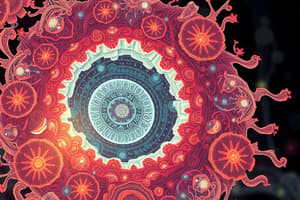Podcast
Questions and Answers
What is the primary role of checkpoints in the cell cycle?
What is the primary role of checkpoints in the cell cycle?
- To boost energy production for cell growth
- To enhance nutrient absorption in cells
- To regulate gene and protein activity ensuring proper cell division (correct)
- To initiate apoptosis in damaged cells
Which cyclin-CDK pair is primarily associated with the S phase of the cell cycle?
Which cyclin-CDK pair is primarily associated with the S phase of the cell cycle?
- Cyclin D - CDK4
- Cyclin A - CDK2
- Cyclin B - CDK1
- Cyclin E - CDK2 (correct)
Which factor is crucial for the commitment to DNA replication at the restriction point?
Which factor is crucial for the commitment to DNA replication at the restriction point?
- Increased fatty acid levels
- Rb protein inactivation (correct)
- CDK activity suppression
- Cyclin D phosphorylation
How do cyclins differ from cyclin-dependent kinases (CDKs) regarding availability?
How do cyclins differ from cyclin-dependent kinases (CDKs) regarding availability?
Which molecule is primarily responsible for holding E2F in a repressed state during the cell cycle?
Which molecule is primarily responsible for holding E2F in a repressed state during the cell cycle?
What is the primary function of p21 in cell cycle regulation?
What is the primary function of p21 in cell cycle regulation?
What consequence occurs due to increased cyclin-CDK activity?
What consequence occurs due to increased cyclin-CDK activity?
Which stage in the cell cycle corresponds to the activity of cyclin B-CDK1?
Which stage in the cell cycle corresponds to the activity of cyclin B-CDK1?
How does the phosphorylation state of pRb affect its activity?
How does the phosphorylation state of pRb affect its activity?
What consequence does Rb phosphorylation have during the cell cycle?
What consequence does Rb phosphorylation have during the cell cycle?
Which statement best describes the transition from maternal to zygotic control during embryonic development?
Which statement best describes the transition from maternal to zygotic control during embryonic development?
Which of the following describes a fundamental difference between pluripotent and differentiated cells in terms of cell cycle regulation?
Which of the following describes a fundamental difference between pluripotent and differentiated cells in terms of cell cycle regulation?
Which of the following is the primary cyclin-CDK pair associated with cell division?
Which of the following is the primary cyclin-CDK pair associated with cell division?
What role do transcription factor complexes play in the regulation of the cell cycle?
What role do transcription factor complexes play in the regulation of the cell cycle?
Which of the following best defines the term 'totipotent'?
Which of the following best defines the term 'totipotent'?
In which stage of development do cells begin to lose pluripotency and start the differentiation process?
In which stage of development do cells begin to lose pluripotency and start the differentiation process?
What regulatory mechanism primarily governs the activity of cyclin A during the transition to mitosis?
What regulatory mechanism primarily governs the activity of cyclin A during the transition to mitosis?
How does the DREAM complex influence the cell cycle?
How does the DREAM complex influence the cell cycle?
What cellular event is specifically associated with increased activity of fatty acid synthase (FASN) during the cell cycle?
What cellular event is specifically associated with increased activity of fatty acid synthase (FASN) during the cell cycle?
What occurs to the DNA content during the G2 phase of the cell cycle?
What occurs to the DNA content during the G2 phase of the cell cycle?
Which molecule is primarily involved in blocking cyclin/CDK activity during cell cycle regulation?
Which molecule is primarily involved in blocking cyclin/CDK activity during cell cycle regulation?
During which phase of the cell cycle is the genetic material fully decondensed?
During which phase of the cell cycle is the genetic material fully decondensed?
What is the role of p53 in the regulation of the DREAM complex?
What is the role of p53 in the regulation of the DREAM complex?
What phase expansion is associated with the reversal of cellular differentiation?
What phase expansion is associated with the reversal of cellular differentiation?
Which two molecules toggle between the formation of DREAM and active transcription complexes?
Which two molecules toggle between the formation of DREAM and active transcription complexes?
What is required for the initiation of the S phase in the cell cycle?
What is required for the initiation of the S phase in the cell cycle?
Flashcards are hidden until you start studying
Study Notes
Regulation of the Cell Cycle
- Checkpoints monitor cell cycle progression, ensuring proper division and genomic integrity.
- Critical checkpoints include G1, G2, and M phases, assessing DNA damage and readiness for synthesis and mitosis.
- Each checkpoint regulates gene and protein activity, influencing cell growth and division.
Steps and Stages of the Cell Cycle
- G1 phase: cell growth and preparation for DNA synthesis.
- S phase: DNA replication occurs, resulting in sister chromatids.
- G2 phase: further growth, preparation for mitosis, and DNA repair.
- M phase: mitosis and cytokinesis, resulting in two daughter cells.
Commitment to DNA Replication
- The restriction point in G1 determines whether the cell will commit to DNA replication.
- Molecules involved include cyclins, CDKs, and the Rb protein, which regulates E2F activity.
Cyclins and Cyclin-Dependent Kinases (CDKs)
- Cyclins are proteins that regulate the timing of the cell cycle, while CDKs are enzymes activated by cyclins.
- Each cyclin-CDK pair triggers processes specific to cell cycle stages, with thresholds determining progression.
- Cyclin D-CDK4/6 pairs are active in G1, Cyclin E-CDK2 in late G1, Cyclin A-CDK1 in S phase, and Cyclin B-CDK1 in G2 and M phase.
Comparing Cyclins and CDKs
- Cyclins have variable availability, with levels fluctuating throughout the cell cycle.
- CDKs are constitutively expressed but remain inactive until bound to cyclins.
Cyclin-CDK Pairs in Cell Division
- Cyclin D-CDK4/6: G1 phase
- Cyclin E-CDK2: late G1 phase
- Cyclin A-CDK2: S phase
- Cyclin A/CDK1 and Cyclin B/CDK1: G2 and M phases
Consequences of Regulatory Changes
- Changes in binding at the E2F promoter can lead to uncontrolled growth or cell cycle arrest.
- Rb phosphorylation alters E2F activity, impacting transcription of genes for progression.
- Cyclin availability and activity influence cell proliferation, affecting fatty acid metabolism and transcription factor complexes.
Key Molecules in Cell Cycle Regulation
- p53: activates DNA repair and apoptosis in response to DNA damage.
- pRb: inhibits E2F activity; its phosphorylation releases E2F, promoting transcription.
- p21: a CDK inhibitor that enforces cell cycle arrest.
- E2F: a transcription factor activated by Rb phosphorylation aiding progression.
- p107/p130: regulate E2F activity similar to pRb.
E2F Promoter Activation and Repression
- Activation involves Rb phosphorylation, allowing E2F to drive transcription.
- Repression occurs when Rb is unphosphorylated, preventing E2F activity.
Transcription and Cellular Division
- Transcription regulation is essential for coordinating gene expression during division.
- Transcription factor complexes activate/repress genes critical for cell cycle progression.
Transcription During and After Mitosis
- Gene transcription decreases during mitosis and resumes rapidly post-mitosis, surprising researchers due to its previously thought uniformity.
Role of Transcription Factors in Differentiation
- Transcription factors influence cellular differentiation by regulating lineage-specific gene expression.
- They guide morphogenesis through orchestrating developmental processes.
Gene Expression and Cell Cycle Regulation
- Gene expression control underpins pluripotency maintenance versus lineage commitment.
- Changes in gene activity can push cells towards differentiation, altering pluripotency.
Definitions
- Totipotent: capable of forming an entire organism.
- Pluripotent: can differentiate into nearly any cell type.
- Embryonic stem cell: pluripotent cells derived from the early embryo.
- Determination: process where a cell becomes committed to a specific fate.
- Specialization: process of acquiring specific functions.
- Differentiation: transformation into a different cell type.
- Morphogenesis: the biological process that causes an organism to develop its shape.
Steps Associated with Morphogenesis
- Involves mechanical forces, cell migration, differentiation, and morphogen gradients.
Control Transitions
- Maternal control transitions to zygotic control at the onset of embryogenesis.
Genes Associated with Pluripotency
- Key pluripotency factors include Oct4, Sox2, and Nanog.
Differences Between Pluripotent and Differentiated Cells
- Pluripotent cells exhibit longer cell cycle stages compared to differentiated cells, which have shorter cycles as they are often more specialized.
Programming vs. Reprogramming
- Programming involves decisions that maintain pluripotency; reprogramming reverses differentiation to restore pluripotent states, altering regulatory circuits and stage lengths.
Cyclin/CDK Pairs and Cell Cycle Progression
- G1 to S phase progression is mediated by cyclin E/CDK2.
- During the S phase, cyclin E/CDK2 remains active.
- G2 to M phase transition involves cyclin A with either CDK1 or CDK2.
- During mitosis (M phase), cyclin B/CDK1 is involved.
Regulation of Cell Cycle Progression
- To prevent entry into mitosis, cyclin A is regulated through transcriptional mechanisms that manage its availability.
Cellular Differentiation and Cell Cycle
- Reversal of cellular differentiation is linked to the S phase, indicating a need for DNA synthesis.
- Differentiation primarily expands the G1 phase.
- Pluripotency in cells corresponds with prolonged or enlarged S phases.
Genetic Material Changes during the Cell Cycle
- DNA is copied in the S phase.
- Cells exhibit double DNA content in G2 phase.
- Chromosomes condense during prophase.
- Mitosis separates sister chromatids in anaphase, restoring normal DNA content at the end.
- Meiosis involves homologous chromosomes separation at Anaphase I and sister chromatids at Anaphase II.
- Full decondensation of genetic material occurs during telophase and telophase II.
- At the end of meiosis, each daughter cell has half the DNA content.
Initiation of S Phase
- Initiation requires Rb phosphorylation and E2F activation for transcription of E2F target genes.
- Additionally, it involves lipogenesis, fatty acid metabolism, and increased CDK2 activity.
Role of Fatty Acid Synthase (FASN)
- FASN is crucial for G1 to S phase transition; its activity is directly linked to cell cycle regulation.
- Loss of FASN correlates with increased apoptosis in dividing cells.
DREAM Complex Formation
- The DREAM complex is formed in response to signals indicating the cell is not ready to enter S phase.
Indirect Regulation of DREAM Complex
- p53 acts as an indirect regulator of the DREAM complex by binding to DNA and activating p21.
p21 Functionality
- p21 is a negative regulator that inhibits cyclin/CDK activity, effectively blocking cell cycle progression when active.
Toggle Mechanism between DREAM and Active Transcription Complexes
- The transition between the DREAM complex and active transcription complexes is controlled by p107 and p130.
- Phosphorylation levels determine the state: HYPER phosphorylation leads to active transcription factor complex; HYPO phosphorylation leads to the DREAM complex.
Studying That Suits You
Use AI to generate personalized quizzes and flashcards to suit your learning preferences.




